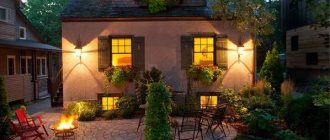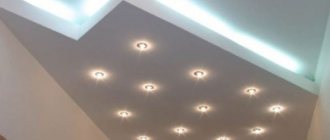Fence lighting: why?
Fence lighting plays an important role when decorating the area around a dacha or country house. With the right choice, lamps can complement the landscape design of almost any area.
Fence lighting performs several key tasks at once. First of all, they are designed to ensure ease of movement in the dark and operation of outbuildings, therefore they are often installed near garage doors, gates, garden paths, etc. They also perform a security function - an area that is well lit at night time, less “attractive” to attackers.
When illuminated, additional video cameras can be placed along the fence to monitor the perimeter. Another function of lamps installed on the fence is decorative. They are able to complement and emphasize various architectural elements, provide illumination for garden plants, and create contrasts and accents on certain elements of the landscape.
Street lighting tasks
Lanterns and lamps in the garden area and fence perform several important functions:
Original design of forged lamps for a fence with forged sections
- Help protect the site from uninvited guests;
- Emphasize the decorative design of the landscape;
- Provide access roads, gates and gates with good visibility;
- They highlight and emphasize the architectural feature of the fence.
Outdoor lighting devices transform the space around the house and along the perimeter of the fence. They help create an atmosphere of comfort, peace and security. Both stationary hedges and decorative borders on the playground and in the recreation area for adults, areas around garden ponds, alpine slides and hedges need lighting.
Return to contents
Preparing to illuminate the fence perimeter
The organization of lighting on fence posts and sections, like any electrical installation work, begins with preliminary preparation. Its first stage is the correct choice of lamps. When choosing outdoor lighting devices, you should take into account such a parameter as the dust and moisture protection class - the most optimal in this case are IP67 and IP68. When preparing a lighting scheme, you should also remember the climatic characteristics of the region.
For example, the height of the lamps should be sufficient to ensure that they continue to perform their functions under the maximum possible layer of snow.
It is important to know! At the preparatory stage, issues such as the choice of location for controlling the backlight, the layout of the lamps and the type of wire that needs to be selected for street installation are resolved.
You also need to decide on connecting the lighting fixtures to the network. For this purpose, a distribution panel of a private house, equipped with a separate automatic switch for outdoor lighting, is suitable. An additional switch can be placed separately in the corridor, on the street or on the fence itself.
However, the most profitable option is to use a special photo relay that automatically turns on the lighting at night and turns it off at the first rays of sunlight.
How to make fence perimeter lighting with your own hands
Read the step-by-step instructions for organizing fence perimeter lighting yourself. Strictly follow the sequence of actions.
Preparatory activities
To get started, you will need materials and tools. Buy from an electrical store:
- cable;
- electrical tape;
- corrugated box;
- lamps.
The average cost of a double-insulated PVC cable is 30 rubles/m, a corrugated pipe is 25 rubles/m. Electrical tape for 25 m will cost you about 100 rubles. The tools you will need are a screwdriver, a tester, a drill, pliers and a sharp knife.
Marking and digging a trench
To begin, mark the section along which the cable will be laid, starting from the distribution panel and ending with the fence. Next, dig trenches of suitable depth with a width of up to 30 cm. The minimum cable laying depth is 70 cm, and the trench must be placed away from bushes (0.75 m), trees (1.5 m) and the fence itself (0.6 m) . Be sure to remove any foreign objects, including rhizomes, stones, and sticks. The trench must be filled with clean sand with a layer thickness of 10 cm. Do not forget to compact it.
Before laying the cable, level the bottom of the trench as much as possible and make sure there are no sharp changes. Otherwise, during the process of soil shrinkage, the electrical cable may simply be damaged.
Electrical wiring for outdoor lighting (laying cables in trenches)
Hide the electrical wire inside the corrugated box and begin installation. Make sure that the cable lies in waves, without tension. After all cables have been laid, the trench should be backfilled. Proceed as follows:
- Inspect the wiring and make sure there is no damage by running a tester.
- If there are no problems, fill the trench with sand (the top layer should be at least 10 cm thick).
- Compact the surface by stomping your feet.
- Place a layer of excavated soil on top of the sand (at least 20 cm).
- Place warning tape in the ground to prevent damage to the cable when excavating again.
- Fill the trench completely, but you don’t have to compact the soil, since the soil will still settle over time.
Connecting street lighting to the installed utility network
After this, you need to place the lights on the site, and then connect each of them to the laid cable:
- Strip the ends of the wire.
- Twist the phase wire with the central contact of the lamp.
- Perform isolation.
- Make sure the insulation is tight.
- Use a tester to check resistance and ground.
After this, the cable lying in the trench can be connected to the switches and distribution panel, supplying electricity.
Installation of an automatic outdoor lighting control system
To automate outdoor lighting, you can use a special photocell that will close/open the electrical circuit. Connect and configure it to ensure that the lighting equipment operates automatically.
Important! No photocell can distinguish artificial light from natural light, so the sensor must be located in a place where it will be exposed exclusively to daylight
You should know it
On the Internet you can find various instructions on how to make outdoor lighting.
The most important thing is that in the end everything turns out harmonious and in the daytime all the lighting fixtures do not contrast with the exterior concept. That is why before you start working, you need to draw up a diagram.
Today there is a huge selection of street lighting products on offer, and often buyers’ eyes literally run wild.
Be sure to draw up a plan diagram of the location of all lighting items. At the same time, you need to think about how the power cable will be laid.
After this, proceed to drawing up an electrical connection diagram. If you doubt your own abilities, it is better to trust the specialists. This is the only way to be completely sure of safety.
Experts in their field do not recommend illuminating the house from the fence. This will create a blinding effect.
Therefore, when preparing a diagram, it is important to take into account all the nuances, even minor ones at first glance.
Options for planning street lighting for country houses and dachas
Without a pre-developed project for installing supports, poles for lamps, and wiring diagrams, it is impossible to carry out high-quality installation of lighting devices.
Garden lighting has different goals and objectives, each of them has its own ideas and solutions.
Having decided on your ideas, you need to carefully consider the number and location of lighting fixtures
You should select in advance areas that require additional light, connection points, and connecting devices with cables. To do this, you will need sockets with moisture-proof characteristics (they are hidden in junction boxes and lamp supports). Switches are located at the owner’s request (where it is convenient for him).
It is easier to apply the diagram on the territory plan (copy). And if there is no such thing, then you can draw a project (1 to 100), with markings of all buildings.
The following locations are indicated on the plan:
- dots with light;
- switches;
- sockets;
- motion sensors;
- cameras.
An example of drawing up a lighting scheme for a garden plot
During design, it is necessary to carefully consider all lighting elements located on the site
It is important to pay attention to dangerous areas, entrances to buildings, and gates. Installation of LED elements on the fence is not recommended due to the possible glare effect
The height of the spotlight must be correct, since in winter, snow can completely cover the device.
When choosing lighting devices, it is important to take into account the climatic features of the region
The final result will depend on the personal preferences of the residents of the house, their budget and imagination. If you don’t have the opportunity or desire to come up with a design yourself, it’s better to turn to professionals for help. The main thing is to choose good specialists.
Lamps placed on the shore of a reservoir will create a mysterious and enigmatic atmosphere
If desired, the lamps can be placed even at the bottom of the reservoir
How to choose fence lighting
Basically, lanterns are placed next to the entrance and entry gates to illuminate the entrance and ensure safety and comfort of movement in the dark. Fence lighting is also needed near the parking area, rest area or along the entire perimeter of the fence.
Features of choice depending on the operating principle
When purchasing fence lights, you must be guided by the following information:
- lanterns can provide directional or diffuse light, be equipped with a light sensor (automatically turn on in the dark) or motion. There are battery-powered and remote-controlled models;
- street lamps must have a waterproof design;
- lamps can be floor lamp type, wall lamp (sconces), mushroom lamps, portable (clothespins), duralight.
Powerful pole lights
Powerful fence lights illuminate the area adjacent to the fence, which is quite extensive. Depending on the design of the lantern, the internal, external or both sides can be illuminated. Reflective lighting with a reflective surface inside the lampshade provides a powerful stream of directional light. The power of such flashlights ranges from 70 to 400 W.
Fence spotlights
Compact lamps are placed pointwise, using them as designer lighting. Their lighting power is low (varies from 15 to 40 W), and they are placed both in the section area and on fence posts. Spot lighting is a backlight, an additional component of the main one.
Additional selection criteria
In landscape lighting, lantern lamps of various designs and designs are used - from inconspicuous to works of art. Operating conditions determine the presence of special characteristics of street lighting devices. These are waterproof, impact-resistant, lightweight, and resistant to changing weather conditions.
Choosing lamps for lanterns
Incandescent lamps are almost never used for street lighting, especially in closed types of lamps. Halogen ones are more expensive, work longer (about 2000 hours), and shine brighter. Metal halides require special additions and also get very hot. Fluorescent lamps work only at positive temperatures, require special additions, and do not stand out among the rest. LED flashlights have many advantages - they are economical, shine brightly, are durable and have many other advantages.











